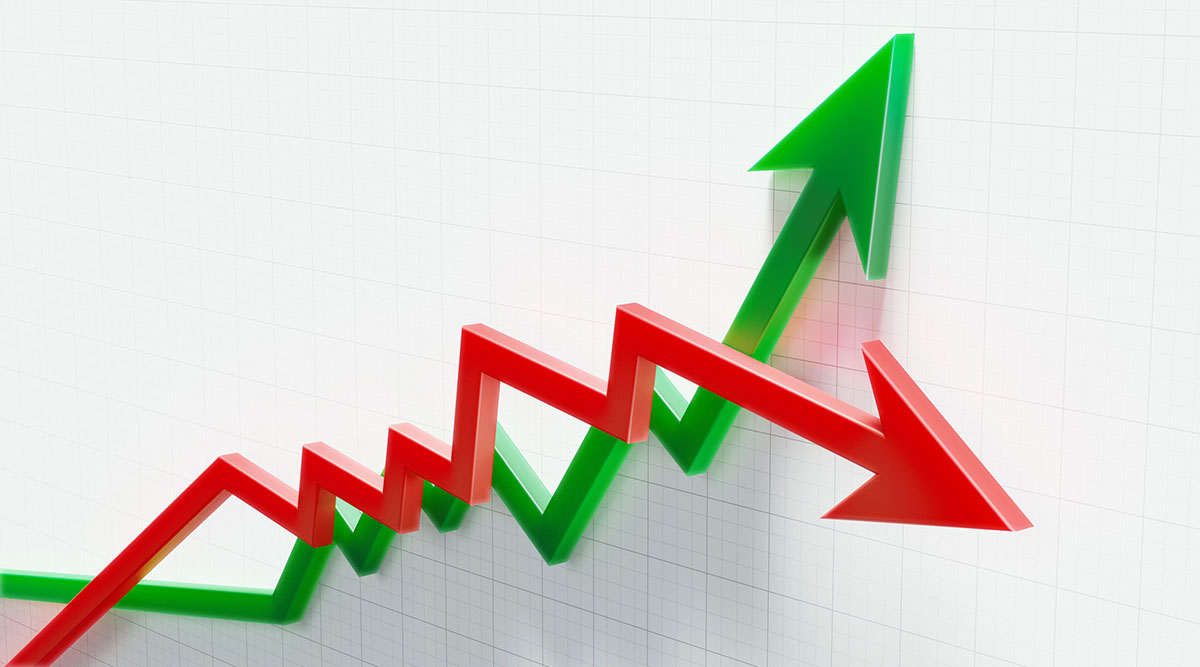

Finance
Why The Stock Market Goes Up And Down
Modified: February 21, 2024
Discover the intriguing patterns behind stock market fluctuations and understand the fundamentals of finance that drive the rise and fall of stocks.
(Many of the links in this article redirect to a specific reviewed product. Your purchase of these products through affiliate links helps to generate commission for LiveWell, at no extra cost. Learn more)
Table of Contents
Introduction
The stock market is a dynamic entity that often leaves investors and casual observers wondering why it experiences constant fluctuations. In order to understand why the stock market goes up and down, it is essential to grasp the various factors and forces that influence its movements.
Investing in the stock market can be a highly rewarding venture, but it also carries a significant degree of risk. To successfully navigate the waters of the stock market, it is crucial to have a solid understanding of the underlying mechanisms that drive its ups and downs.
At its core, the stock market is driven by the principle of supply and demand. This simple economic concept forms the basis for explaining the price movements of stocks. When there is high demand for a particular stock, its price tends to rise. Conversely, when there is low demand, the price may decline.
However, the factors influencing supply and demand are multifaceted and complex. Economic principles, market sentiment, company performance, interest rates, global events, and market speculation all play a role in determining the direction of the stock market.
In this article, we will delve into the intricacies of the stock market and explore the key factors that contribute to its volatility. By gaining a deeper understanding of these forces, investors can make more informed decisions, mitigate risk, and potentially capitalize on the opportunities presented by market fluctuations.
Economic Principles and Market Demand
Economic principles underpin the foundation of the stock market and influence its movements. Key economic indicators such as GDP growth, inflation rates, and employment figures can significantly impact market demand.
When the economy is thriving, with robust GDP growth and low levels of unemployment, investor confidence tends to be high. This positive sentiment leads to increased demand for stocks as investors seek to capitalize on the potential for higher returns.
Conversely, during economic downturns or recessions, market demand tends to decline. Uncertainty about the future of the economy can erode investor confidence, causing a decrease in stock prices.
Market demand also depends on factors specific to individual industries or sectors. A company’s prospects for growth, its competitive position, and its ability to generate profits all influence market demand for its stock. For example, emerging industries such as renewable energy or technology often attract high demand due to their potential for innovation and growth.
Investor sentiment is a crucial element in understanding market demand. Behavioral finance theories suggest that human emotions can drive market movements. During periods of optimism, investors may exhibit a “herd mentality” and rush to buy stocks, driving up market demand. Conversely, during periods of fear or uncertainty, investors may sell off their holdings, leading to a decrease in market demand.
External events, such as changes in government policies, trade disputes, or geopolitical tensions, can also impact market demand. These events can create volatility in the market as investors react to the perceived risks or opportunities posed by such developments.
Overall, economic principles and market demand are intrinsically linked. Understanding the economic landscape, as well as investor sentiment, is essential in comprehending the forces that drive the stock market’s ups and downs.
Investor Sentiment and Market Psychology
Investor sentiment and market psychology play a crucial role in determining the movements of the stock market. Emotional factors such as fear, greed, and optimism can greatly influence the buying and selling decisions of investors.
When investors are optimistic about the future prospects of the economy or a specific company, they tend to be more inclined to buy stocks, driving up market prices. This positive sentiment can create a self-fulfilling prophecy, as increased buying activity leads to further price appreciation.
Conversely, when investor sentiment turns negative, fear often takes hold, leading to selling pressure and price declines. The fear of potential losses or a perceived downturn in the market can cause investors to panic and sell their holdings, intensifying downward price movements.
Market psychology also plays a role in creating market cycles. The famous investor Warren Buffett once said, “Be fearful when others are greedy and greedy when others are fearful.” This highlights the importance of contrarian investing, where investors take positions opposite to the prevailing sentiment in the market.
The phenomenon of herd mentality is another aspect of investor sentiment. The fear of missing out (FOMO) can create a sense of urgency among investors who see others profiting from certain stocks. This can lead to a rush of buying activity, inflating prices and creating potential bubbles.
Moreover, market sentiment can be influenced by media coverage and the dissemination of news. Positive or negative news about a company or the overall market can shape investor sentiment, leading to corresponding buying or selling behavior.
Understanding investor sentiment and market psychology is crucial for investors to make informed decisions. It is important to differentiate between short-term fluctuations driven by emotions and long-term trends based on fundamentals. By studying investor behavior and sentiment, investors can gain insights into the prevailing market sentiment and adjust their strategies accordingly.
Company Earnings and Financial Performance
The financial performance of individual companies is a significant factor in determining the movement of the stock market. Investors closely monitor a company’s earnings, revenue growth, profit margins, and other financial indicators to assess its overall health and potential for future growth.
When a company reports strong earnings and exceeds market expectations, it often leads to increased investor confidence and a rise in stock prices. Positive earnings surprises can attract more investors to buy shares, thereby boosting market demand and driving the market upward.
Conversely, disappointing earnings or a decline in a company’s financial performance can have the opposite effect. If a company fails to meet expectations or reports a decline in profits, investors may lose confidence and sell off their holdings, leading to a decrease in stock prices.
In addition to earnings, other financial metrics such as revenue growth, balance sheet strength, and cash flow also impact investor sentiment. Companies with sustainable revenue growth, solid financial positions, and efficient cash flows are typically viewed more favorably by investors, leading to increased demand for their stock.
Investors also consider factors such as market share, product innovation, and competitive advantages when evaluating a company’s financial performance. Companies that demonstrate consistent growth, successful product launches, and a competitive edge in their industry tend to attract more investor interest and support.
It is important to note that a single company’s financial performance can have a broader impact on the stock market. Large-cap or widely-held companies, often referred to as “blue-chip” stocks, can have a significant influence on market indices such as the S&P 500 or Dow Jones Industrial Average. When these companies report earnings, it can move the overall market in a specific direction.
Overall, company earnings and financial performance serve as a critical barometer for investors to assess the value and growth potential of individual stocks. By carefully analyzing these factors, investors can make informed decisions and position themselves to take advantage of market movements.
Interest Rates and Monetary Policy
Interest rates and monetary policy set by central banks have a significant impact on the stock market. Central banks, such as the Federal Reserve in the United States, use monetary policy tools to influence economic growth, inflation, and employment. The decisions they make regarding interest rates directly affect the cost of borrowing for businesses and consumers, and in turn, can greatly influence stock market movements.
When interest rates are low, borrowing costs decrease, making it more attractive for businesses to invest and expand their operations. This leads to increased corporate profits, which can drive stock prices higher. Additionally, low interest rates can make it more affordable for consumers to finance large purchases, stimulating overall economic activity and boosting market demand.
Conversely, when interest rates rise, borrowing becomes more expensive, potentially slowing down business investment and consumer spending. Higher interest rates can also impact the valuation of stocks as investors may shift their investments to fixed-income assets that offer more attractive returns. This can lead to a decrease in market demand and a subsequent decline in stock prices.
Monetary policy decisions and statements made by central bank officials can also significantly impact investor sentiment. Market participants closely analyze central bank announcements for hints about future interest rate changes or shifts in policy direction. Strong indications of monetary tightening can lead to market volatility as investors reposition their portfolios in anticipation of potential economic changes.
In addition to interest rates, other aspects of monetary policy, such as quantitative easing or tightening, can also influence the stock market. These measures involve the purchase or sale of government securities by central banks to increase or decrease the money supply. The impact of these policies on market liquidity and investor expectations can contribute to significant market movements.
It is important for investors to closely monitor interest rate decisions and the overall monetary policy environment to understand how it may impact the stock market. By staying informed and anticipating potential shifts, investors can make informed decisions and adjust their investment strategies accordingly.
Global and Geopolitical Events
Global and geopolitical events have the power to significantly impact the stock market and drive its movements. Events such as trade disputes, political instability, natural disasters, and changes in international relations can create volatility and uncertainty in the market.
Trade disputes between major economies, such as the United States and China, can have far-reaching effects on the stock market. Tariffs and trade barriers imposed by countries can disrupt global supply chains and impact the profitability of companies operating in affected industries. International investors closely monitor trade negotiations and announcements regarding tariffs, as any developments can lead to significant market fluctuations.
Political instability and changes in government policies can also influence the stock market. Elections, political unrest, or shifts in leadership can create uncertainty, causing investors to react by buying or selling stocks. Investors may perceive a political party or a particular policy stance as favorable or unfavorable to certain industries or sectors, leading to corresponding market movements.
Global economic events, such as recessions or financial crises, have profound implications for the stock market. The 2008 financial crisis, for example, led to a severe downturn in global markets as financial institutions faced collapse and economic growth stagnated. Events like these can trigger fear and panic among investors, resulting in significant market declines.
Natural disasters, such as hurricanes, earthquakes, or pandemics, can also have an impact on the stock market. These events can disrupt supply chains, cause damage to infrastructure, and have economic repercussions. Investors may react by selling stocks of companies directly affected by the disaster and reallocating their investments to sectors that are expected to benefit from the recovery efforts.
Furthermore, changes in international relations and geopolitical tensions can affect the stock market. Conflicts, wars, or the threat of terrorism can create uncertainty and concern among investors. Heightened geopolitical tensions can lead to increased market volatility and a flight to safe-haven assets, impacting stock prices.
It is crucial for investors to stay informed about global and geopolitical events that may impact the stock market. By understanding the potential consequences of these events, investors can make more informed decisions and adjust their investment strategies accordingly.
Market Speculation and Manipulation
Market speculation and manipulation can influence the stock market and contribute to its ups and downs. Speculation refers to the practice of making investment decisions based on anticipated future price movements rather than fundamental analysis. Speculators often rely on technical indicators, market trends, and sentiment to predict short-term fluctuations in stock prices.
Speculation can have a significant impact on market demand and supply. When speculators anticipate a rise in stock prices, they may buy shares, increasing market demand and driving up prices. Conversely, if speculators anticipate a decline in prices, they may sell shares, leading to a decrease in demand and causing prices to fall.
Market manipulation refers to actions that are intended to artificially influence stock prices for personal gain. Manipulative practices can include spreading false information, engaging in pump and dump schemes, or engaging in insider trading. These actions can distort the market and create a false perception of a company’s value, leading to price manipulation.
Pump and dump schemes involve artificially inflating the price of a stock through false information or exaggerated claims. Once the price has risen, the manipulators sell their shares, causing the price to plummet and leaving unsuspecting investors with significant losses.
Insider trading, another form of market manipulation, occurs when individuals with access to non-public information trade stocks based on that information. This unfair advantage allows insiders to profit at the expense of other market participants, distorting the integrity and fairness of the market.
Regulatory bodies and stock exchanges have implemented measures to detect and prevent market manipulation. These include strict rules on disclosures, insider trading restrictions, and surveillance systems to monitor trading activities for suspicious behavior. However, it is challenging to completely eliminate market manipulation, as perpetrators can devise new methods to circumvent regulations.
Market speculation and manipulation can create volatility and uncertainty in the stock market. It is essential for investors to be aware of these practices and exercise caution when making investment decisions. By focusing on long-term fundamentals and undertaking thorough research, investors can mitigate the risks associated with market speculation and manipulation.
Supply and Demand of Stocks
The principle of supply and demand is a fundamental driver of stock market movements. The supply of and demand for stocks directly impact their prices, leading to the constant fluctuations observed in the market.
Supply refers to the number of shares available for trading in the market. The supply of stocks can be influenced by various factors, including initial public offerings (IPOs), secondary offerings, and stock buybacks. When a company goes public through an IPO or issues additional shares through a secondary offering, it increases the supply of its stock in the market. On the other hand, when a company repurchases its own shares through stock buybacks, it reduces the supply of its stock.
Demand, on the other hand, represents the willingness of investors to buy stocks at a specific price. The demand for stocks is influenced by various factors, including investor sentiment, economic conditions, company performance, and market trends. When investors have a positive outlook on the economy and believe in the growth potential of a specific company, they are more likely to demand its stock, leading to higher prices.
Changes in supply and demand dynamics can lead to fluctuations in stock prices. When supply exceeds demand, there is downward pressure on prices as sellers compete to attract buyers. Conversely, when demand exceeds supply, there is upward pressure on prices as buyers compete to secure available shares.
Institutional investors, such as pension funds, mutual funds, and hedge funds, play a significant role in the supply and demand dynamics of the stock market. Their buy or sell decisions can significantly impact stock prices and market trends. For example, if a large institutional investor decides to sell off a significant portion of its holdings, it can create a surplus of supply and lead to downward pressure on prices.
Moreover, market sentiment and investor psychology can also influence the supply and demand dynamics. Positive news or market optimism can lead to increased buying activity, driving up demand and prices. Conversely, negative news or market pessimism can drive selling activity, increasing supply and pushing prices down.
It is important for investors to closely monitor supply and demand dynamics in the stock market. By understanding the factors that impact supply and demand, investors can make informed decisions and potentially capitalize on market trends and price movements.
Market Volatility and Risk
Market volatility and risk are inherent characteristics of the stock market. Volatility refers to the magnitude of price fluctuations in the market, while risk refers to the potential for losses or adverse outcomes. Understanding and managing these elements is crucial for investors seeking to navigate the stock market effectively.
Market volatility can be influenced by a variety of factors, including economic indicators, company news, geopolitical events, and investor sentiment. Periods of high volatility often coincide with increased uncertainty and can lead to sharp price swings in the stock market. Conversely, periods of low volatility are characterized by relative stability and smaller price movements.
Investors should be cautious of excessive market volatility, as it can introduce both opportunities and risks. High volatility can present opportunities for short-term traders to profit from price fluctuations, but it also increases the potential for losses if market swings are unpredictable. It is important for investors to assess their risk tolerance and investment objectives before engaging in strategies that involve capitalizing on volatility.
Risk in the stock market encompasses a range of factors. One significant risk is the potential for loss of capital. Stocks represent ownership in companies, and their values can fluctuate, causing investors to experience declines in their investments. The magnitude of risk varies among different stocks and sectors. For example, stocks of established blue-chip companies may be viewed as less risky compared to those of small, speculative companies that may exhibit higher volatility.
Other types of risk in the stock market include systemic risk, which arises from events affecting the entire market, such as financial crises or recessions. Political and regulatory risks can emerge from changes in government policies or regulations that impact specific industries. Company-specific risks can arise from factors such as poor management decisions, product failures, or legal issues.
To manage risk in the stock market, diversification is a common strategy. By investing in a variety of stocks across different sectors and asset classes, investors can spread their risk and potentially mitigate losses from individual stock or sector downturns. Additionally, setting a clear investment strategy, conducting thorough research, and regularly reviewing and adjusting your portfolio can help manage risk effectively.
It is important for investors to recognize that risk and volatility in the stock market cannot be completely eliminated. However, by understanding and managing these factors, investors can make more informed decisions, minimize potential losses, and position themselves to take advantage of investment opportunities.
Conclusion
The stock market is a dynamic and ever-changing entity driven by a multitude of factors. Understanding the reasons behind its constant fluctuations is essential for investors seeking to navigate the market effectively and maximize their investment potential.
Economic principles and market demand fundamentally influence stock prices. Factors such as GDP growth, employment figures, and investor sentiment play a significant role in shaping market dynamics. Additionally, company earnings and financial performance are crucial in determining investor confidence and the overall health of the stock market.
Interest rates and monetary policy set by central banks can greatly impact market movements. Changes in interest rates affect borrowing costs for businesses and consumers, influencing investment decisions and market demand. Furthermore, global and geopolitical events introduce volatility and uncertainty into the market, demanding investors’ attention and careful analysis.
Market speculation and manipulation present further complexities. Investor sentiment and psychological factors can sway market movements, while manipulative practices can distort prices and undermine market integrity. Recognizing and navigating these elements is crucial in making informed investment decisions.
Finally, the interaction between supply and demand of stocks shapes market forces. Understanding the availability of shares and investor demand is key to comprehending stock price movements. The market’s inherent volatility and risks must be acknowledged and managed effectively through diversification, thorough research, and a clear investment strategy.
In conclusion, the stock market’s ups and downs are a culmination of various economic, psychological, and external factors. By understanding these factors and staying informed, investors can develop a well-rounded perspective of the market and make more informed investment decisions. While volatility and risks persist, with careful analysis and a long-term approach, investors can potentially capitalize on opportunities and achieve their financial goals within this dynamic landscape.














